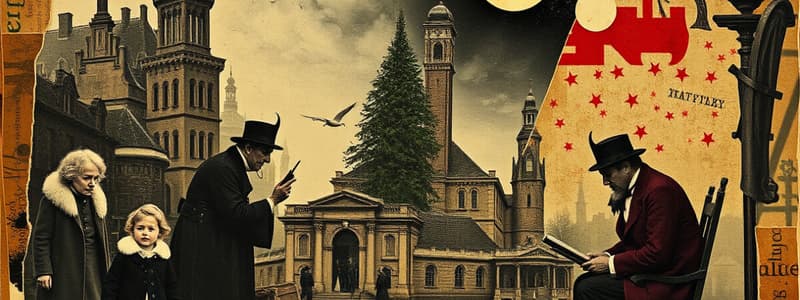Podcast
Questions and Answers
What genre is 'A Christmas Carol'?
What genre is 'A Christmas Carol'?
Allegory
What does Scrooge mean when he says, 'A year older not an hour richer'?
What does Scrooge mean when he says, 'A year older not an hour richer'?
It signifies Scrooge's disdain for material wealth and portrays his lonely existence.
What does Scrooge's reaction to the charity workers reveal about his character?
What does Scrooge's reaction to the charity workers reveal about his character?
It shows his lack of empathy and misanthropic nature.
What does Marley symbolize when he says, 'Mankind was my business'?
What does Marley symbolize when he says, 'Mankind was my business'?
How is the Ghost of Christmas Past described?
How is the Ghost of Christmas Past described?
What do the children Ignorance and Want represent?
What do the children Ignorance and Want represent?
What significant change does Scrooge undergo in Stave 3?
What significant change does Scrooge undergo in Stave 3?
What is the significance of Scrooge's realization regarding his own funeral?
What is the significance of Scrooge's realization regarding his own funeral?
What does Scrooge fear about the silent shape in Stave 4?
What does Scrooge fear about the silent shape in Stave 4?
What does Tiny Tim symbolize in 'A Christmas Carol'?
What does Tiny Tim symbolize in 'A Christmas Carol'?
Flashcards are hidden until you start studying
Study Notes
Genre
- A Christmas Carol is an allegorical tale emphasizing social responsibility and community care.
Stave 1 - Scrooge and Fred
- Scrooge's line "A year older not an hour richer" contrasts with Fred's belief that Christmas brings moral wealth.
- Pathetic fallacy presents Scrooge's isolation, with cold, smog-filled descriptions reinforcing his character's gloom.
- The phrase "External heat and cold had no effect on Scrooge" indicates his emotional detachment from others.
- His characterization as "hard and sharp as flint" foreshadows the transformative influence of the ghosts.
Stave 1 - Charity Workers and Poverty
- Dickens critiques the upper class's exploitation of the poor, emphasizing societal indifference with "many thousands lack common necessities."
- Scrooge’s response to charity workers illustrates his lack of empathy, exemplified by his dismissal of prisons and workhouses.
- The concept of "ignorance and want" introduced by the Ghost of Christmas Present signifies societal neglect of the underprivileged.
- Vivid imagery of the neglected poor, particularly Tiny Tim, reflects Dickens's call for compassion from the upper class.
Stave 1 - Marley
- Marley’s ghost symbolizes social responsibility, stating that "Mankind was my business" to emphasize the responsibility we owe one another.
- Marley’s chains represent the consequences of a selfish life, described as "innocent torture of remorse."
Stave 2 - Ghost of Christmas Past
- The ghost’s illuminating characteristics signify the beginning of Scrooge's path to redemption.
- Reveals Scrooge's backstory and foreshadows his potential for growth and change.
- The ghost’s changing physical form represents human potential and the fluidity of character.
- The Spirit's omniscience suggests Scrooge's past is not fixed and emphasizes the importance of learning from experiences.
Stave 3 - Ghost of Christmas Present
- The ghost, described as a "jolly giant," embodies the spirit of Christmas and generosity, contrasting sharply with Marley's shackled existence.
- The warning about "Ignorance" and "Want" highlights the dangers of societal neglect towards the poor.
- Scrooge’s growing realization of his impact on others culminates in feelings of warmth and remorse.
Stave 3 - The Character of Scrooge
- Scrooge’s phrase "A tremendous family to provide for" shows his continued focus on wealth rather than compassion.
- Scrooge's penitent reaction to his past words signifies genuine remorse and the desire to change.
- His contrast from earlier views demonstrates the beginning of his character transformation towards empathy.
Stave 4 - Summary
- The indifference of wealthy businessmen towards Scrooge’s death underscores the lack of empathy in Victorian society.
- Scrooge realizes he could suffer the same fate as the "unhappy man," indicating his readiness to change.
- The scenes with the Cratchit family and Tiny Tim trigger deep remorse, highlighting the consequences of neglecting the needy.
Stave 4 - Key Quotes
- Scrooge's trembling fear before the silent ghost indicates the psychological impact of his encounters with the spirits.
- The businessmen's cold conversations about Scrooge’s funeral reflect their materialistic worldview.
- The phrase "I will honour Christmas in my heart" shows Scrooge's commitment to change, marking his transformation from selfishness to compassion.
Tiny Tim
- Scrooge’s emotional plea for Tiny Tim's survival reveals his emerging feelings of sympathy for the lower class.
- The acknowledgment of Tiny Tim’s potential death serves as the final catalyst for Scrooge's moral awakening and commitment to change.
Studying That Suits You
Use AI to generate personalized quizzes and flashcards to suit your learning preferences.




